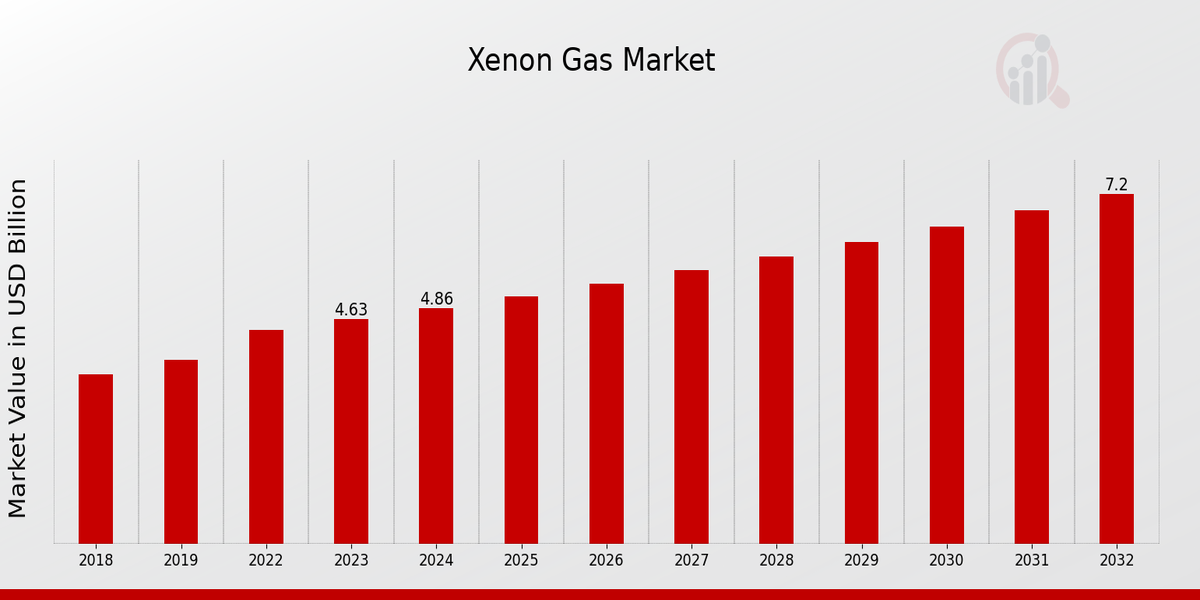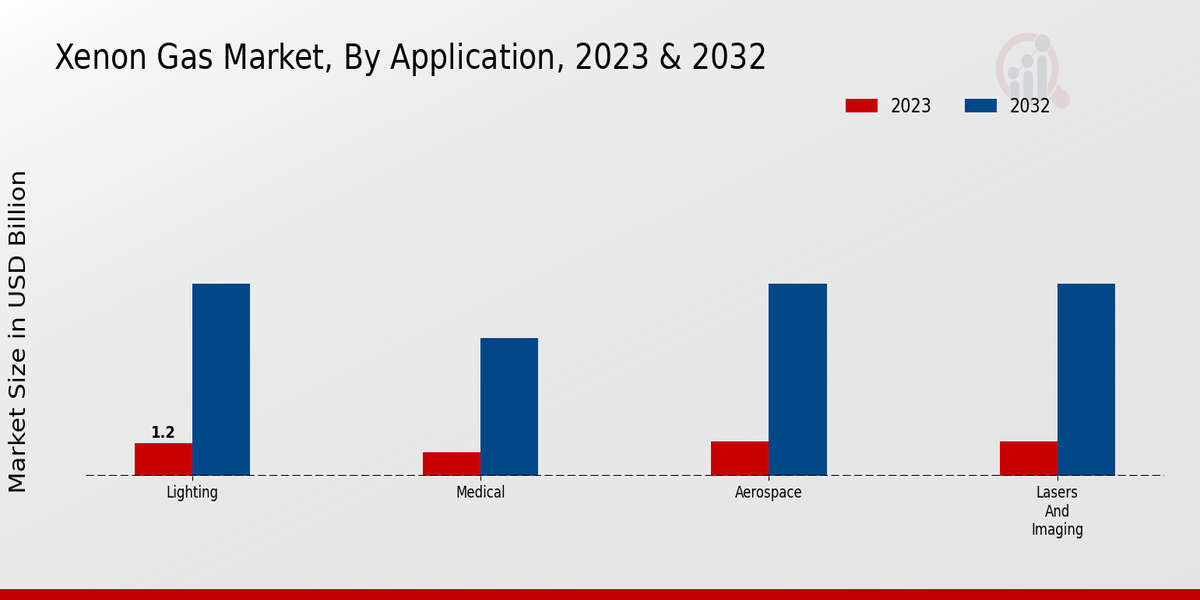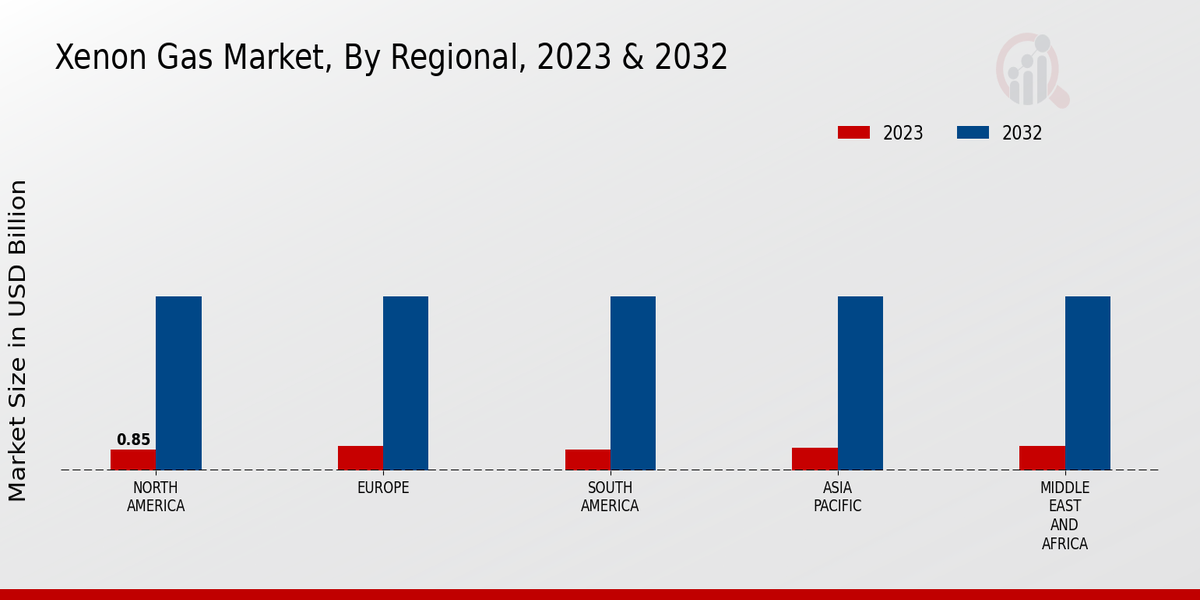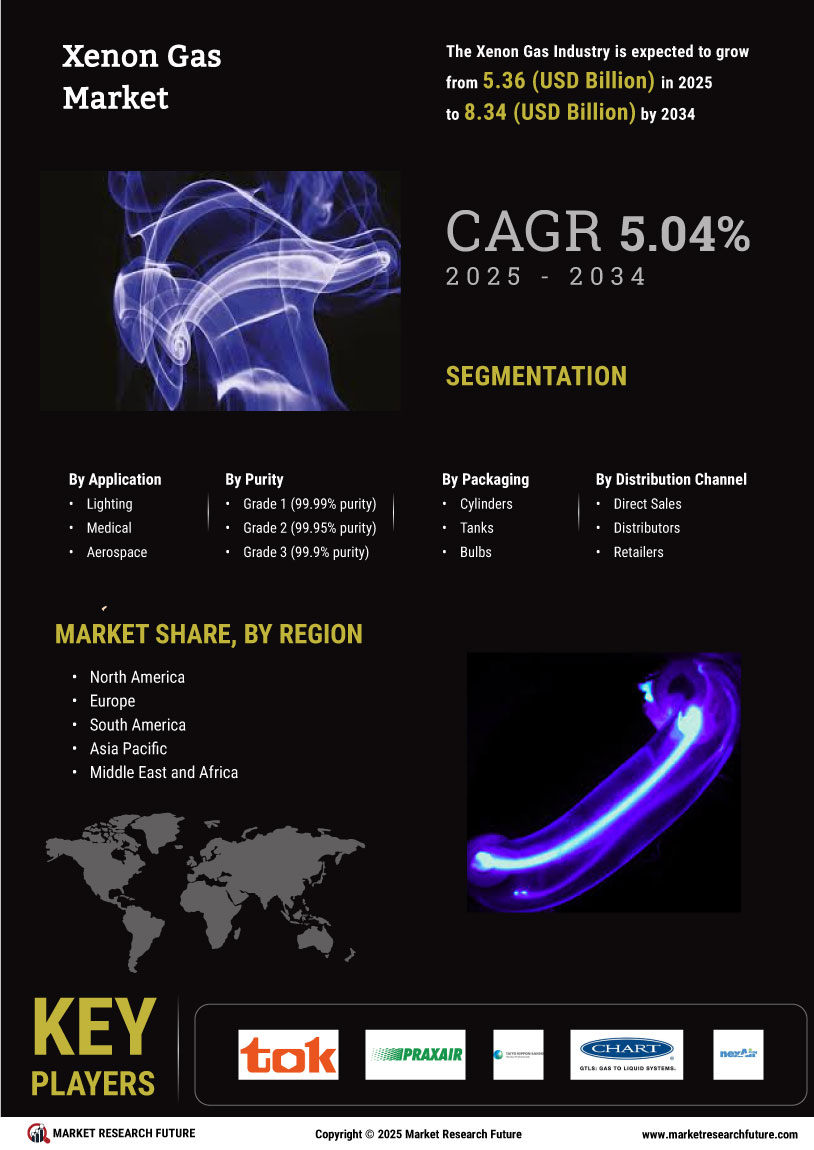Global Xenon Gas Market Overview
The Xenon Gas Market Size was estimated at 5.10 (USD Billion) in 2024. The Xenon Gas Industry is expected to grow from 5.36 (USD Billion) in 2025 to 8.34 (USD Billion) by 2034. The Xenon Gas Market CAGR (growth rate) is expected to be around 5.04% during the forecast period (2025 - 2034).
Key Xenon Gas Market Trends Highlighted
The Xenon Gas Market is characterized by rising demand from various end-use industries. The growing adoption of advanced technologies, particularly in medical imaging and lighting sectors, has spurred demand for xenon gas. The increasing prevalence of minimally invasive surgeries and the need for improved diagnostic imaging capabilities contribute to the market expansion.Key market drivers include the expanding use of xenon gas in medical applications such as anesthesia, pain management, and diagnostic imaging. Advancements in aerospace technologies and the increasing demand for high-intensity lighting solutions in industries like automotive and photography further contribute to market growth.Emerging trends in the xenon gas market include the development of alternative production methods to reduce the reliance on traditional extraction techniques. Exploration of novel applications in the semiconductor and electronics industries presents opportunities for market expansion. Additionally, the growing emphasis on minimizing environmental impact through recycling and waste management systems is driving sustainable practices within the xenon gas supply chain.

Source: Primary Research, Secondary Research, MRFR Database and Analyst Review
Xenon Gas Market Drivers
- Growth in the Semiconductor Industry
One of the primary factors fueling the demand for xenon gas is the growth of the semiconductor industry. This is due to the fact that xenon is used in the manufacture of semiconductors, and, as such, the increasing demand for semiconductors drives the increasing demand for xenon gas. The semiconductor industry is projected to grow at a CAGR of 5.0% over the next five years. This is largely driven by the increasing ubiquity of a variety of electronic devices, such as smartphones, laptops, and tablets – an effect that is also expected to continue driving the demand for xenon gas.
Increasing Demand for Medical Imaging
Another substantial contributor to the demand for xenon gas is the increasing demand for medical imaging. Xenon gas is typically used in combination with CT scans and MRI scans. Medical imaging is becoming increasingly in demand due to the rising incidence of chronic diseases such as cancer and heart diseases. Therefore, the increasing prevalence of these diseases will similarly spur the demand for xenon gas.
Expansion of the Aerospace Industry
Expansion of the aerospace industry The expansion of the aerospace industry is also driving the demand for xenon gas. Xenon is used in the manufacturing of rocket engines and other aerospace applications. The increasing demand for aerospace products is expected to drive the demand for xenon gas. The expansion of the aerospace industry is being driven by the increasing demand for air travel and the increasing demand for satellite-based services. The increasing demand for these services is expected to continue to drive the demand for xenon gas.
Xenon Gas Market Segment Insights:
Xenon Gas Market Application Insights
The attached Xenon Gas Market is segmented by application, namely Lighting, Medical, Aerospace, Lasers, and Imaging. Lighting is the most significant application segment and is expected to contribute more than 50% of the Xenon Gas Market revenue by 2023. The surge in Xenon gas demand is mainly driven by its increasing use in auto lighting. Xenon headlamps are significantly brighter and more efficient than traditional halogen headlamps, providing enhanced visibility and reducing the possibility of a crash. As a result, the demand for Xenon gas is set to surge with increasing employment of xenon and high-intensity discharge headlamps in both luxury and sport and luxury vehicles.Medical is another relatively important application segment contributing approximately 25% of the Xenon Gas Market revenue. The increase in the number of surgical procedures and in the incidence of chronic diseases is leading to a demand for minimally invasive surgeries and ultimately to the surge in the application of Xenon gas, which is used for anesthesia, pain management, and in Xe-CT and xenon MRI techniques, among others. Aerospace is an emerging application segment accounting for about 15% of the Xenon Gas Market revenue. The growing investment in space programs is expected to result in the development of more spacecraft fitted with ion thrusters and in aerospace, reaching a 20% share of Xenon Gas Market revenue by 2023.The decline in helium sources, mainly in the US and Russia, may lead to a surge in the global demand for Xenon gas for operational purposes in commercial and defense missions or in satellite repurposing to boost the sales for the segment. Finally, Lasers and Imaging, although constituting only about 10% of the Xenon Gas Market revenue in 2015, is increasing with time and is also an important revenue driver. Xe-CT techniques that use Xenon gas have introduced new applications in medical and ventilation studies. Hence, Lasers and Imaging is forecast to reach a 15% market share in 2023, with the overall application increasing by approximately 40% compared to 2015.

Source: Primary Research, Secondary Research, MRFR Database and Analyst Review
Xenon Gas Market Purity Insights
The leading segment, by purity level, which accounted for the maximum Xenon Gas Market revenue, was grade 1. It is relatively pure, having a level of 99.99%. The grade is popular in the medical industry and is mostly utilized as anesthesia and dense narcotic gas for pain management. The next largest segment with a purity level of 99.95 is the grade 2 neon gas. It’s used for a variety of industrial applications, including lighting and lasers. The 99.9% pure xenon is grade 3, and it is mainly used for research and development reasons in numerous industries.Over the projection period, this segment is predicted to expand substantially. The rising demand for high-purity xenon gases in the healthcare and electronics industries is driving the market’s expansion.
Xenon Gas Market Packaging Insights
The Packaging segment of the Xenon Gas Market is primarily driven by the increasing demand for Xenon gas in medical applications, particularly in anesthesia and imaging procedures. The key packaging types used for Xenon gas include cylinders, tanks, and bulbs. Cylinders are the most common type of packaging, as they are easy to transport and handle. Tanks are used for larger volumes of Xenon gas, while bulbs are used for smaller volumes. The growth of the Packaging segment is attributed to the increasing adoption of Xenon gas in various applications, such as medical imaging, lighting, and aerospace.The segment is expected to witness significant growth in the coming years, driven by the increasing demand for Xenon gas in these applications.
Xenon Gas Market Distribution Channel Insights
The distribution channel segment plays a crucial role in the Xenon Gas Market, influencing market growth and revenue generation. Direct Sales, Distributors, and Retailers are the primary channels through which Xenon Gas reaches end-users. Direct Sales involve manufacturers selling directly to customers, providing personalized service and control over product distribution. Distributors act as intermediaries, purchasing Xenon Gas in bulk and distributing it to various retailers and industries. Retailers, such as specialty gas suppliers and medical equipment providers, sell Xenon Gas directly to end-users, offering convenience and accessibility.The Xenon Gas Market segmentation by distribution channel provides insights into market dynamics, sales strategies, and customer preferences. This segmentation helps market players tailor their distribution strategies to optimize reach, enhance customer satisfaction, and drive revenue growth.
Xenon Gas Market Regional Insights
The regional segmentation of the Xenon Gas Market provides insights into the geographical distribution of market growth. North America held the largest market share in 2023, accounting for approximately 37% of the Xenon Gas Market revenue. This dominance is attributed to the presence of major healthcare and semiconductor industries in the region. Europe is another significant market, contributing around 28% to the global revenue in 2023. The growth in Europe is driven by increasing demand from the automotive and lighting industries.APAC region is expected to witness the fastest growth during the forecast period, with a CAGR of 6.2%. This growth is fueled by the expanding healthcare and electronics sectors in countries like China and India. South America and MEA regions are also expected to contribute to the overall market growth, albeit at a slower pace.

Source: Primary Research, Secondary Research, MRFR Database and Analyst Review
Xenon Gas Market Key Players And Competitive Insights:
Presently, major players in the Xenon Gas Market industry invest continually in research and development to gain a stronger competitive advantage. Top Companies in the Xenon Gas Market depend on innovative technologies and solutions to meet the specific needs of their clients. An important factor that can be observed in the Xenon Gas Market Competitive Landscape is that it is extremely competitive between existing players and new entrants. In addition to this, Xenon Gas Market is characterized by the predominance of various companies’ strategies, such as acquisitions, strategic partnerships and collaborations to enhance their market presence together with these firms’ competitive position. Industry players pay particular attention to merging and acquiring existing companies as a successful measure to extend their market share and gain new access to technologies and markets. The major Xenon Gas Market growth drivers include increased demand from healthcare and semiconductor industries, technological innovations and government regulations.One of the top competitors operating in the Xenon Gas Market is Iwatani – the largest Japanese company that is focused on the production and supply of industrial gas. Iwatani has a significant global presence in the Xenon Gas Market and is known for its exceptional product quality and high reliability of supply. The company is also oriented on innovation and customer satisfaction, which allows it to secure strong customer loyalty. Iwatani invests consistently in research and development for its Xenon Gas Market segment to extend its market presence. There are several levels of competitors for the company to consider.Another large competitor in the Xenon Gas Market is Praxair Technology, Inc. – a global leader in terms of production and supply capacity of industrial gas. Praxair Technology, Inc. offers a very extended product portfolio in the Xenon Gas Market. In addition to this, the company maintains a highly reliable distribution network, allowing it to reach a large range of customers. The firm has a strong market position due to its high level of safety, a broad range of innovative solutions and good customer service. At present, Praxair Technology, Inc. is actively developing its presence in the Xenon Gas Market and is also focused on developing new technologies to meet individual customers’ needs.The choice between these two competitors is affected by the product range and laws governing the supply of industrial gas in a certain country.
Key Companies in the Xenon Gas Market Include
- Tokyo Oxygen Co., Ltd.
- Praxair Technology, Inc.
- Taiyo Nippon Sanso
- Chart Industries, Inc.
- Nexair LLC
- Matheson TriGas, Inc.
- Air Water Inc.
- The Linde Group
- Iwatani Corporation
- Air Products and Chemicals, Inc.
- Air Liquide S.A.
- Pacific Industrial Gases
- Messer Group
- Las Vegas Oxygen Company
- Weldstar
Xenon Gas Market Industry Developments
The Xenon Gas Market is projected to reach a value of USD 8.34 billion by 2034, exhibiting a CAGR of 5.04% during the forecast period. Increasing demand from the semiconductor industry, healthcare sector, and automotive sector is driving the market growth. Xenon gas is used in excimer lasers, which are essential for the production of semiconductors. The growing demand for consumer electronics and the increasing adoption of advanced semiconductor technologies are driving the demand for xenon gas. Additionally, the increasing use of xenon gas in medical imaging and anesthesia is contributing to market expansion. The automotive sector is also witnessing increased demand for xenon gas for use in high-intensity discharge (HID) headlamps.
Xenon Gas Market Segmentation Insights
- Xenon Gas Market Application Outlook
- Lighting
- Medical
- Aerospace
- Lasers and Imaging
- Xenon Gas Market Purity Outlook
- Grade 1 (99.99% purity)
- Grade 2 (99.95% purity)
- Grade 3 (99.9% purity)
- Xenon Gas Market Packaging Outlook
- Xenon Gas Market Distribution Channel Outlook
- Direct Sales
- Distributors
- Retailers
- Xenon Gas Market Regional Outlook
- North America
- Europe
- South America
- Asia Pacific
- Middle East and Africa
| Report Attribute/Metric |
Details |
| Market Size 2024 |
5.10 (USD Billion) |
| Market Size 2025 |
5.36 (USD Billion) |
| Market Size 2034 |
8.34 (USD Billion) |
| Compound Annual Growth Rate (CAGR) |
5.04% (2025 - 2034) |
| Report Coverage |
Revenue Forecast, Competitive Landscape, Growth Factors, and Trends |
| Base Year |
2024 |
| Market Forecast Period |
2025 - 2034 |
| Historical Data |
2020 - 2024 |
| Market Forecast Units |
USD Billion |
| Key Companies Profiled |
Tokyo Oxygen Co., Ltd., Praxair Technology, Inc., Taiyo Nippon Sanso, Air Products and Chemicals, Inc., Chart Industries, Inc., Nexair LLC, Matheson TriGas, Inc., Air Water Inc., The Linde Group, Iwatani Corporation, Air Liquide S.A., Pacific Industrial Gases, Messer Group, Las Vegas Oxygen Company, Weldstar |
| Segments Covered |
Application, Purity, Packaging, Distribution Channel, Regional |
| Key Market Opportunities |
Medical Imaging Automotive Lighting Semiconductor Manufacturing Lighting Fixtures Lasers |
| Key Market Dynamics |
Increasing demand in semiconductor manufacturing Growing medical applications Government regulations on xenon use Fluctuations in raw material prices Technological advancements in xenon extraction and purification |
| Countries Covered |
North America, Europe, APAC, South America, MEA |
Frequently Asked Questions (FAQ) :
The Xenon Gas Market was valued at USD 5.10 billion in 2024 and is projected to reach USD 8.34 billion by 2034, exhibiting a CAGR of 5.04% during the forecast period.
The Asia Pacific region is expected to dominate the Xenon Gas Market, accounting for a significant share of the market in 2023 and is projected to maintain its dominance throughout the forecast period.
Key applications of Xenon Gas include lighting, medical imaging, and anesthesia. It is also used in semiconductor manufacturing, aerospace, and scientific research.
Major players in the Xenon Gas Market include Air Liquide, Linde, Praxair, Iwatani, and Messer.
The growth of the Xenon Gas Market is primarily driven by increasing demand from the medical and lighting industries. The growing adoption of minimally invasive surgical procedures and the increasing use of xenon gas in medical imaging techniques are contributing to the market growth.
The Xenon Gas Market faces challenges such as supply chain disruptions, price volatility, and stringent regulations governing the production and handling of xenon gas.
The Xenon Gas Market is projected to register a CAGR of 5.04% during the forecast period from 2025 to 2034.
Key trends shaping the Xenon Gas Market include the development of new applications in the medical field, increasing adoption of energy-efficient lighting solutions, and growing emphasis on environmental sustainability.
Opportunities for growth in the Xenon Gas Market lie in the expansion of the healthcare industry, the development of innovative lighting technologies, and the increasing demand for xenon gas in scientific research.
Key strategies adopted by players in the Xenon Gas Market include capacity expansion, strategic partnerships, technological advancements, and geographical expansion.


















